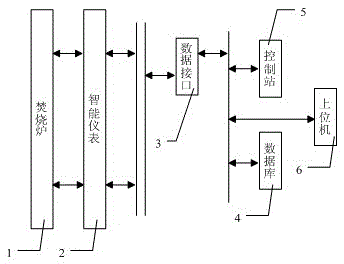Swarm intelligence machine learning incinerator harmful emissions control system and method
A machine learning, emission compliance technology, applied in general control systems, control/regulation systems, adaptive control, etc., can solve problems such as COD exceeding the standard and COD not being able to be measured online.
- Summary
- Abstract
- Description
- Claims
- Application Information
AI Technical Summary
Problems solved by technology
Method used
Image
Examples
Embodiment 1
[0096] refer to figure 1 , figure 2 , the incinerator harmful emission control system based on swarm intelligence machine learning, including the on-site intelligent instrument 2 connected to the incinerator 1, the DCS system and the host computer 6, the DCS system includes a data interface 3, a control station 5 and a database 4, The field intelligent instrument 2 is connected with the data interface 3, and the data interface is connected with the control station 5, the database 4 and the upper computer 6, and the upper computer 6 includes: a data preprocessing module for inputting data from the DCS database The model training samples are preprocessed, and the training samples are centered, that is, the average value of the samples is subtracted, and then standardized:
[0097] Calculate the mean: TX ‾ = 1 N Σ i = 1 ...
Embodiment 2
[0140] refer to figure 1 , figure 2 , a method for controlling the discharge of harmful substances in an incinerator based on swarm intelligence machine learning. The specific implementation steps of the control method are as follows:
[0141] 1) For the process object of incinerator harmful emissions, according to the process analysis and operation analysis, determine the key variables used, collect the data of the variables when the production is normal from the DCS database as the input matrix of the training sample TX, and collect the corresponding COD and the operational variable data to make the COD emission reach the standard as the output matrix Y;
[0142] 2) Preprocess the model training samples input from the DCS database, and centralize the training samples, that is, subtract the average value of the samples, and then standardize them so that the mean value is 0 and the variance is 1. This processing is accomplished using the following algorithmic procedure:
...
PUM
 Login to View More
Login to View More Abstract
Description
Claims
Application Information
 Login to View More
Login to View More - R&D
- Intellectual Property
- Life Sciences
- Materials
- Tech Scout
- Unparalleled Data Quality
- Higher Quality Content
- 60% Fewer Hallucinations
Browse by: Latest US Patents, China's latest patents, Technical Efficacy Thesaurus, Application Domain, Technology Topic, Popular Technical Reports.
© 2025 PatSnap. All rights reserved.Legal|Privacy policy|Modern Slavery Act Transparency Statement|Sitemap|About US| Contact US: help@patsnap.com



